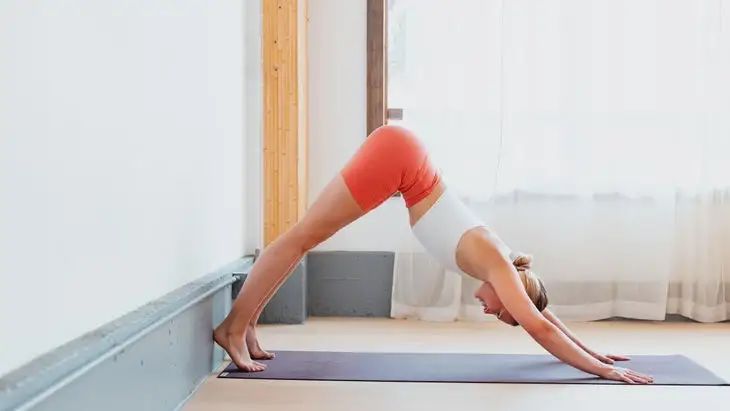We all know the benefits of Yoga AIDS.

Today we recommend a very good Yoga AIDS, which can be found without effort – it is the wall.

Practicing yoga is a process of constantly finding the body and mind.

The wall provides solid and unambiguous support and feedback, paving the way for the creation of new neural pathways and physical and mental communication.

Whether the goal is to provide extra support or learn to activate muscles, walls are your best friends.

Today, these eight asanas are very common in daily practice, but with the help of the wall, it can be safer and deeper, activate the body’s awareness, and find the feeling of positive position.

The downward dog leaning against the wall provides support for the trainees whose heels cannot touch the ground, stabilizes the heels so that they will not turn inward or outward, and activates the muscles in the front of the legs to lean the short edge of the mat against the wall.

Prepare for the four legged kneeling position with the hips up and back into the downward dog pose.
Place the heel on the wall and the forefoot on the mat.
Activate the quadriceps femoris to reduce the weight of the hand.
Pull your upper arm outward toward the wall behind you.
Maintain 5-10 breaths.
The Warrior III wall helps you maintain balance while adjusting your posture and keep your hips in the right position, so that you can experience and integrate the correct spine and hips in the posture, align the walking stick sitting and standing to measure the position of your feet, and stand in the measured position.
Bend forward and put your hands on the mat.
One leg went back to the wall.
Put your feet on the wall at hip height.
Lift the torso half way, parallel to the cushion.
The phantom chair type wall with both hands in front of the chest helps to prevent knee misalignment.
Pressing the fingers into the wall will help pull the ribs back to the spine to stand facing the wall, and the toes touch the wall.
Your feet can be together, or they can be as wide apart as your hips.
Put your fingertips on the wall, bend your knees, pull your hips back, and lean your knees against the wall as if you were going to sit down.
Sit back as far as possible, keep your toes touching the wall, and keep breathing for 5-10 times.
Lean against the wall with four columns to practice against the wall to avoid wrist compression.
There is no downward gravity, so you can more easily practice the upright position of the spine.
Stand facing the wall, arm away.
Put your palm on the wall.
Hands shoulder width.
Inhale, lift your heels, exhale, bend your elbows, and lengthen your tailbone.
Keep 5-10 breaths against the wall.
The dog type practice against the wall can avoid wrist compression, help learn to stabilize the lower back and bend upward and outward from the middle back and upper back.
In a new way, exercise the muscles at the back of the body to stand facing the wall, with both arms straight and palms on the wall at shoulder height.
Slightly bend your elbows, keep your hands shoulder width apart, and your feet hip width apart.
Press your hands against the wall, and tilt your upper body back slightly to enter the back bend.
Lift your chest to the sky.
Maintain 5-1 breaths.
Low lunge twist this exercise helps you twist deeply without affecting the alignment of your knees or hips, and creates more space throughout your chest with your knees on the ground and your right hips and shoulders against the wall.
Take a step forward with the right foot, and the right outer leg and thigh are flush with the wall.
Come to the low lunge with the front knee directly above the ankle.
Twist to the wall, the arm is like a fairy palm, the elbow is the same height as the shoulder, and the palm and forearm are close to the wall.
Turn your head and look at your back hand.
As you breathe, press the left elbow and forearm into the wall to further open the right chest.
The camel wall can be used as a contact point to optimize alignment, keep the lower back from unnecessary strain or pressure, provide feedback to support the middle back (thoracic vertebra) extension, kneel facing the wall, keep the knees as wide as the hip, and place a yoga brick on the outside of the ankle.
The thigh touches the wall and is perpendicular to the cushion.
Put your palms on your hips.
Lift the chest and, as you bend back, lift the ribs up and out of the pelvis.
The main areas of curvature are the thoracic vertebrae and cervical vertebrae.
Relax your throat and hold 5-10 breaths.
The pigeon lying posture stretches the hips against the wall, which can relax and maintain the posture for a longer time.
It can stabilize the hips by placing the feet on the wall, and keep the knees and hips aligned on the supine position.
The hips are close to the wall, and the ankles are crossed on the knees of the other leg.
The legs form a 4-Shape.
Put your arms on your sides with your palms up.
Relax the muscles in the face, neck and shoulders.
You can deepen the stretching effect by keeping your hips close to the wall…

